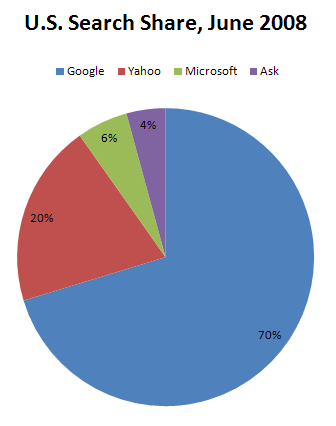Learn the Pros and Cons of Each PPC Search Engine


Welcome to the second article in our latest blog series, Rookie or Veteran – PPC basics every advertiser should know. Today, I am speaking to individuals who haven’t started their PPC campaign yet, or individuals who have started a PPC campaign but are utilizing only one search engine and looking to expand their efforts. I am going to review the pros and cons of each PPC search engine.
The goal of today’s article is to give new comers to PPC a list of opportunities and challenges for each search engine. This list could be 27 miles long but I’ll try to keep my comments succinct and focused. I will focus on the “heavy hitters” pay-per-click search engines: Google, Yahoo and MSN adCenter.
There are dozens of paid search marketing avenues, so why discuss only on 3 of them? If you are just getting your PPC campaign up and running, you should focus your efforts on where you have the highest possibility of generating the most/best traffic. This doesn’t mean that you shouldn’t eventually branch out into other paid search sites, but you should build your PPC foundation with these three search engines. Here is the break down for paid search engine traffic share (from a Hitwise study conducted in June, 2008):

As you can see, Google still possesses the lion share of paid search marketing traffic… so let’s start with them!

Google AdWords is the largest paid search marketing option out there. As you can see from the chart above, AdWords has 70% of paid search traffic. If you want to jump head-first into the paid search marketing pool, this is where you should start. Sure, it has a drawbacks and weaknesses, but AdWords is the most robust of the PPC search engines.
Overall Performance: As with any PPC campaign, you need to continually optimize your campaign in order to achieve the best performance. But Google AdWords can provide a great return on investment. Google still has the majority of search traffic (paid & non-paid) and this is why Google AdWords is the cornerstone of any paid search marketing campaign.
Cost-per-click: Google has the majority of search traffic which is why their cost-per-click tends to be higher than the other search engines – because there is more competition!
Reporting/Visibility: Without a doubt, Google AdWords has the best reporting options and greatest sense of visibility. There is a reason why AdWords continues to dominate the paid search realm every quarter and that is because advertisers can really drill down into the smallest detail of their campaign’s performance. In fact, if you launch your PPC campaign with AdWords, you will almost feel like you’re flying blind with the other search engines.
Quality score initiatives: Google AdWords has the most complex PPC quality score. However, they have also opened some of the black box and given advertisers at least a glimpse of their quality score and what is hindering their performance. Considering the fact that PPC Hero has written dozens of articles on the AdWords Quality Score, you can bet that it’s hard to master which is a very big challenge for account managers.
User interface: Google AdWords has the most user-friendly interface of all the “heavy hitter” search engines. Also, their AdWords Editor makes campaign management/optimization very efficient and easy.
Summary: Google AdWords has the most traffic, the highest visibility, and the most user-friendly interface. All of this (and much, much more) are the reasons why they are the dominant search engine. However, the downside of AdWords is that there is so much competition. Sure, the interface is great, and you have a lot of visibility into your campaign’s performance and this is because you’ll NEED IT. Optimizing your AdWords campaign is a complex process that can significantly improve your performance but you have to know what you’re doing.

The second largest paid search marketing avenue is Yahoo Search Marketing. In most PPC campaigns, Yahoo doesn’t generate nearly the quantity of traffic, leads or revenue as that of Google AdWords. However, it can be a great secondary source of revenue and leads. In the past two years Yahoo has been making positive strides by launching a new user interface (known as Panama) and they have stepped up their quality score initiatives.
Overall performance: As I mentioned, AdWords will be the dominant force for most PPC campaigns. However, depending on your audience and target market, Yahoo may surprise you. Just because Yahoo is second in search volume, but they still generate 2.5 billion searches every month. That’s nothing to sneeze at!
Cost-per-click: The cost-per-click (CPC) in Yahoo is usually lower than on Google AdWords. The CPCs are lower on Yahoo because there less competition. Also, Yahoo’s click quality initiatives haven’t effectws CPCs as drastically as AdWords, yet…
Reporting/visibility: With the launch of Panama in 2007, Yahoo broadened its reporting palette in order to give advertisers mores visibility into their performance. The reports provided by Yahoo are adequate to successfully manage your account, and if you are using Google Analytics for reporting then you should have your bases covered. But Yahoo is leaps and bounds behind Google AdWords when it comes to their reporting functions.
Quality score initiatives: Yahoo has been rolling out their click quality initiatives for over a year now. I’m all for improving search results, and rewarding advertisers who are relevant and provide great user experience. But Yahoo has been increasing their CPC across board due to market reserve pricing. What does this mean? Market reserve pricing is determining the value of a keyword and applying that (usually increased) price to the advertiser. But you can counter balance this system by continually optimizing your campaign for increased performance, just like Google AdWords. Within the interface you can view your Quality Index (at the ad level) and this at least gives you a slight indication as to how Yahoo scores your ad.
User interface: As far as usability is concerned, Panama was a nice step forward for Yahoo (depending who you ask). Yahoo’s old interface was clunky and ancient. Sure, the new interface can be buggy and slow. It’s still a step in the right direction. And if you’re just starting up your PPC campaign, I’m sure the Panama interface will suffice.
Summary: Yahoo can serve ad part of the foundation of a successful paid search campaign. There is less competition but the interface and reporting suite is less robust. There is usually less traffic in Yahoo, but it can be cheaper than AdWords. Like I said earlier, once you get used to all of the capabilities of AdWords, you’ll like you’re flying blind in Yahoo – but you can still make it work.

Microsoft adCenter is the third largest paid search avenue but its traffic is only a fraction of Google. The paid search volume in MSN is 1.1 billion searches per month, only about 1/7 of Google’s quantity. So, going from the #1 position to the #3 position is quite a large leap. MSN adCenter tries to keep up with Google and Yahoo but I don’t know if they’ll ever be able to catch up. But, MSN is worthy of your PPC attention.
Overall performance: As I stated, MSN adCenter generates only a fraction of Google and Yahoo’s traffic. However, there are studies to show that MSN users tend to be more trusting of paid search ads. So, there may be less traffic on MSN but its users are more likely to click on your ads and make a purchase. Keep this in mind.
Cost-per-click: MSN’s cost-per-click tends to be similar to Yahoo, or a little cheaper (this, of course, depends on the keywords you’re targeting). Since there are less users and less competition, this can keep your CPC lower than in Google AdWords.
Reporting/visibility: The reporting functions in MSN are on par with Yahoo. They both still lag behind Google in this category. However, MSN does have some helpful tools in MSN Labs and their keyword research tool is quite good. As I said with Yahoo, compared to Google, you’ll feel like you’re flying blind in MSN.
Quality score initiatives:MSN’s quality algorithm is similar to Google’s. It is based on click-through rate. But unlike Google AdWords, you have no visibility as to what your score is.
User interface: I can’t lie; I think the MSN interface is the weakest of the three. I will give MSN some credit, they have launched a desktop management program for adCenter which makes managing and optimizing your account a breeze. Now, Yahoo is the loser when it comes to desktop programs.
Summary: If you are just launching your PPC campaign, you should focus your efforts on Google AdWords and Yahoo Search Marketing. Once you are comfortable and successful with those campaigns, then you should turn to MSN for supplemental traffic and revenue.
This has been a break down of the pros and cons of the big 3 PPC search engines. As you can see, each search engine has its beneifts and negatives. In order to create a robust PPC campaign, you’ll want to utilize each of these, but keep in mind that you can apply the same universal PPC truths to each one – but they are all different and each requires skill and determination in order to generate the best ROI.



